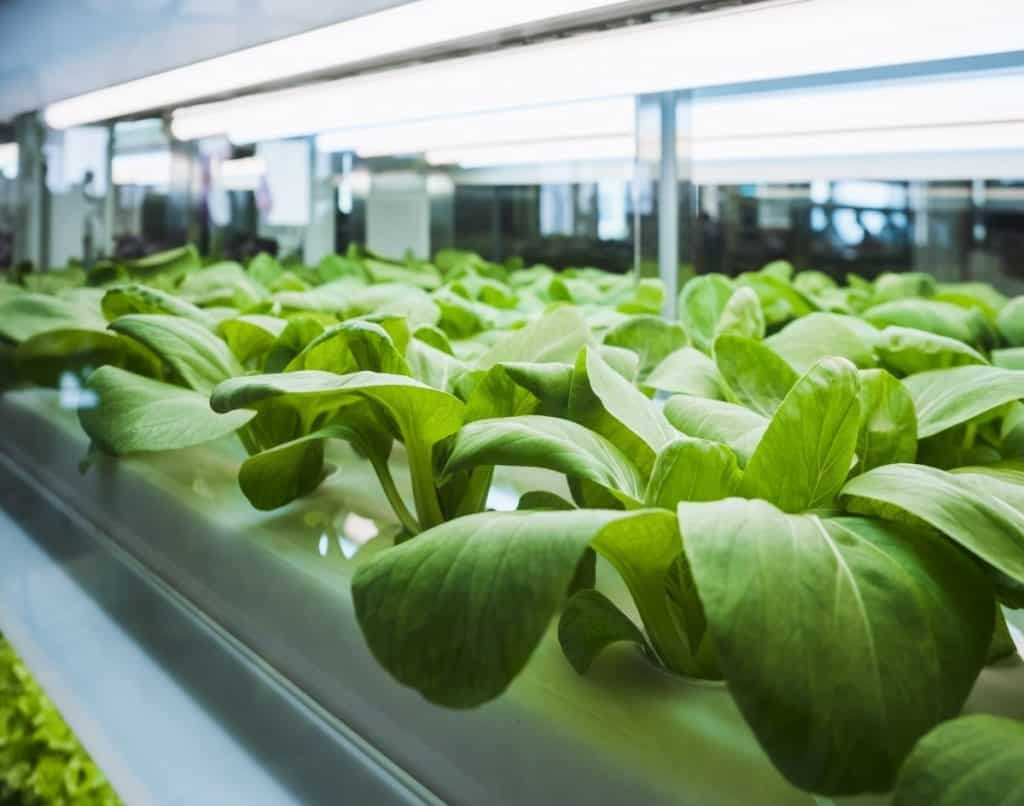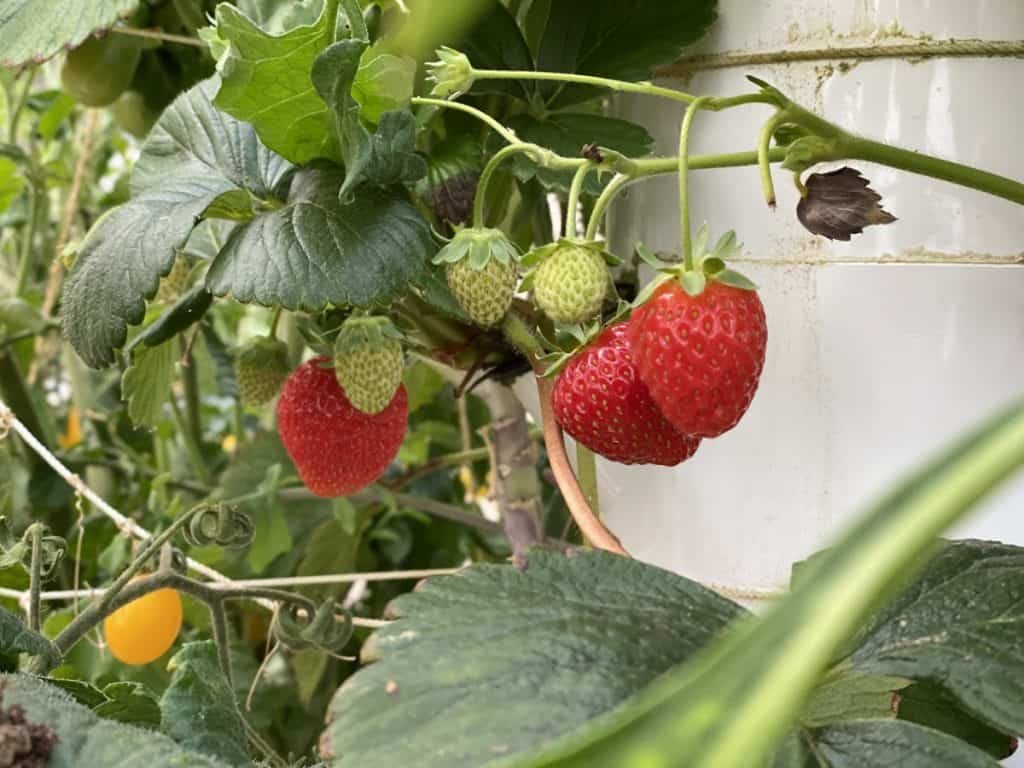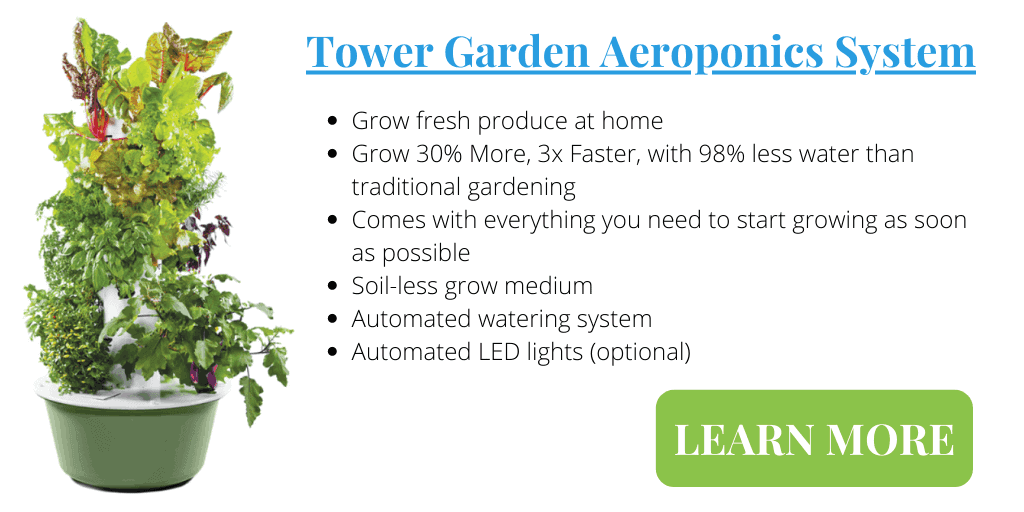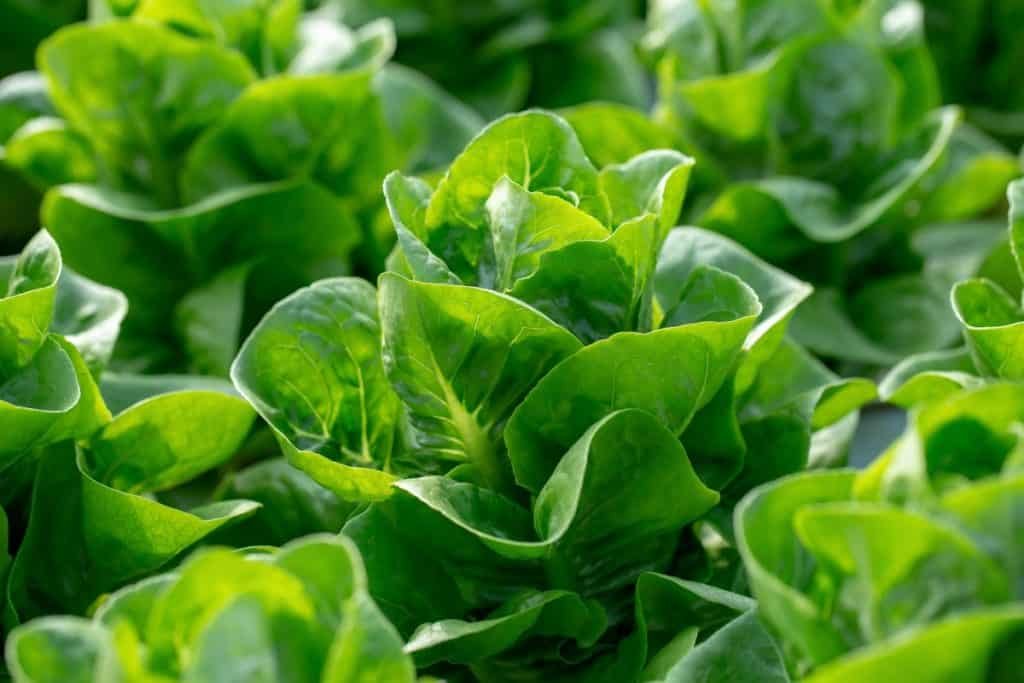Plants do grow faster in a hydroponics system as everything they need to grow has been provided for them, creating perfect conditions in a favorable setting. The nutrients that the plant needs are already broken down in the water. Oxygenated water is delivered to the root system, which allows the plants to absorb the nutrients better.
Because everything that the plant needs is provided for it, it doesn’t have to waste energy searching for what it needs to grow. Instead, the plant can put all its energy into developing and producing delicious, healthy fruit!
Some plants are easier to grow than others, but studies show that hydroponic growing results in full-grown crops at a rate of 20 to 50% quicker than soil-grown plants. Each plant has its own growing cycle, and some could take much longer to grow than others, even in ideal conditions.
Typically, the hydroponic growth cycle of a plant should take 35 to 56 days after planting, compared to a soil-based plant which should start to fruit 40 to 90 days after planting.
You can estimate the growth cycle of a hydroponically grown plant by using the following calculations:
- Determine the average growth cycle of the plant by adding the lowest and the highest period and divide the number by 2.
- When you have the average cycle figure, multiply by 0.8 to determine the hydroponic cycle’s anticipated 20% speedier growth or by 0.5 for the 50% predicted speedier growth rate.
- These values will indicate the estimated growing time in the hydroponics system.

Fast-Growing Vegetables For Hydroponic Systems
Choosing the correct types of plants for your hydroponics growing system is important to ensure a healthy yield. You need to be selective in the plants that you choose to grow in your hydroponics system to avoid disappointment if they don’t grow well in this growing environment.
Hydroponics growing can be a rewarding but frustrating method of growing healthy plants, so planting the correct fast-growing plants in your system allows you to reap the harvest sooner than growing in the soil would.
When growing a variety of plants in the hydroponics environment, group together plants that require the same amounts of nutrients, PH levels, and temperatures. The setup of the hydroponic lighting system is important as well.
Growing plants with the same requirements together in the same containers saves you time as you only need to add the nutrients when required by all the plants without having to top up daily for other plants, which might require more.
For instance, tomatoes and cucumbers grow well together as they have the same needs, and lettuce and spinach are great companions.
These vegetables are fast-growing, perfect for a hydroponics system.
- Lettuce – Lettuce doesn’t need too much space or attention. Leafy lettuce like romaine will thrive in the hydroponics environment. Harvest the outer leaves, and more leaves will grow to replace them. If you are a beginner to the hydroponics world, growing lettuce is the best first vegetable to grow as you can harvest fresh growing leaves from around three weeks after planting. They are a cooler weather vegetable and will bolt if the weather warms up.
- Spinach – Spinach varieties grow well in a moist hydroponics environment. Spinach is ready to harvest from around 14 to 20 days. They don’t need too much space, so you can plant the seedlings close together. Spinach will keep growing for about 12 weeks, so harvest the leaves often. Baby spinach leaves are delicious. Always harvest the baby leaves from the outside of the plant, leaving the inner leaves to grow larger.
- Swiss Chard – A very popular hydroponics plant and a fast grower. The leaves can be harvested from around 35 days, but they will continue to grow and thrive after harvesting. Harvest the outside leaves to allow the inside leaves to continue growing.
- Kale – A versatile plant, kale is easy to grow and thrives in the hydroponics environment. The plant is ready for harvesting in around ten weeks. You can harvest up to 30% of the leaves at any one time as new leaves will grow back, ready for a new harvest. You can grow kale from seeds, but they will grow quicker if you plant and grow seedlings from the local garden center.
- Cucumbers – Cucumbers love hydroponics growing systems! The growing conditions are perfect for them, and they will produce an amazing yield around 50 days after planting or when they are between 8 to 14 inches (20 to 35cms) long, depending on your requirements. They are vine vegetables and require a trellis to grow well. Plant them next to your tomatoes to share the framework.
- Beans – There are hundreds of bean varieties, and they will all grow well in a hydroponics system. They are straightforward to grow and produce an excellent crop. Some varieties are climbing plants and do need support trellises. Beans are ready to harvest about 50 days after planting but will continue to grow for another three to four months, increasing your harvest.
- Spring onions – A perfect plant for hydroponic growing! Each plant produces one dozen shoots which are ready for harvest every three to four weeks. Simply cut each shoot off from the main plant whenever you need it, and new shoots will grow back.
- Radishes – Although radishes are a root vegetable and not ideally suited for growing hydroponically, they are, surprisingly, easy to grow in a hydroponics system. They are one of the quickest plants to grow and are ready for harvest from around three to four weeks after planting. They are susceptible to root rot, so check them regularly.

Fast-Growing Fruits For Hydroponic Systems
Not all fruit plants are suitable for growing hydroponically. While vining and bush-type fruit plants will grow and thrive in most hydroponics environments, larger fruit trees will benefit from the drip irrigation system or the ebb and flow system and will still take a long time to grow.
Miniature and dwarf fruit trees like bananas or lemons will grow well in a controlled hydroponics environment as long as they are properly looked after. They will produce the same sized fruit as regular trees.
These are some of the best fast-growing fruits for a hydroponics system:
- Tomatoes – Tomatoes grow on a vine, so you will have to rig up a trellis of some sort in the hydroponics space. Tomatoes grow year-round and enjoy warmer temperatures. To speed up the growing process, only plant seedlings and space them out as they need room to grow. They are very thirsty plants, so check the water levels and top up daily.
- Bell Peppers – Peppers can be grown in any season. They are large plants so space them out to between 7 and 9 inches (17 to 22cms) apart. Peppers are larger and a better quality when grown in a hydroponics system, but to ensure maximum fruit growth, prune the plant when it reaches about 7 to 8 inches (17 to 20cms). Peppers mature at around 50 to 80 days.
- Blueberries – A top choice for growing hydroponically as they grow better in a controlled environment. Blueberries do take a while to grow and might only produce their first crop after a few months, so you will have to be patient with them. Grow them from established seedlings as starting them from seeds is complex and will take longer for the first harvest.
- Strawberries – Strawberries are our favorite fruit to grow in any hydroponics system! If the temperatures and growing conditions are favorable, they will grow and produce delicious fruit all year long. To speed up the growing process, buy a mature plant from your garden center. The plant will send out new runner shoots and will take up as much space as you allow it.
Fast-Growing Herbs For Hydroponic Systems
Herbs are fantastic plants to grow hydroponically. They are easy to grow and maintain. Most herbs are ready for harvest as soon as leaves appear, but you can leave them to grow longer if you need bigger plants. Buy seedlings from your local garden centers to speed up the growing process.
These herbs are easy to grow and are ready for harvest year-round.
- Chives need plenty of light but not too much water. They take about 6 to 8 weeks to mature, after which they can be harvested daily. After harvesting, they need about three to four weeks to grow again for the next harvest.
- Mint and spearmint are prolific growers! Only plant one or two of each mint or spearmint variety in your hydroponics system as they will spread and take over! Harvest the leaves as soon as they appear, and they will keep growing. Spray clean water over the leaves occasionally to get rid of any mites.
- Basil thrives in a soilless system with plenty of light! When the plant is mature, trim it back to harvest instead of pinching the leaves to encourage better growth. You can gather from this impressive plant every day.
- Coriander will take four weeks to mature and will provide you with two to three harvests per plant. If you stagger the planting times of new seedlings, you will have leaves to harvest year-round.
- Sage is another easy-to-grow herb. Harvest the leaves and trim them back often to encourage new growth.
- Mustard greens and Arugula grow better in a hydroponics system than in soil. Each plant is ready to harvest within three weeks after planting. New growth will be ready for another harvest within two weeks.

Which Vegetables And Fruit Cannot Be Grown Hydroponically?
Although you can grow almost any fruit and vegetable plant in a hydroponics system, some plants are not worth the effort, providing little to no yield, while others are simply too big to fit specific hydroponics systems.
Deep root veggies like potatoes, sweet potatoes, carrots, and turnips require soil to produce a robust and healthy crop. There are ways to grow these crops hydroponically, but they will take a lot more of your time and effort to produce a healthy crop.
They will benefit from a drip watering system as they have extensive root systems and need lots of water.
Corn is the worst vegetable to try and grow in an indoor hydroponics environment. They are too big for growing in an indoor or contained system and are best grown outdoors with room to grow. A drip system would be beneficial to saving you time when watering them.
Pumpkin should not be grown hydroponically. They need room to spread and produce huge fruit, so outdoors in the ground is the place for them to be.
Some plants need bees to pollinate them as they have both male and female flowers growing on them. If these plants grow indoors in a contained system without access for the bees, they will not get pollinated and will not produce good fruit.

Fast Growing Hydroponic Vegetables And Fruit
Growing vegetables and fruit using a hydroponic system will provide you with a year-round supply of healthy, fresh fruit and vegetables. The beauty of growing using a hydroponics system is that you can grow the plants you need when you need them. Because you have grown them yourself, you will know without any doubt that they are indeed chemical-free and which additional nutrients they contain.
Certain plants are well suited for growing in a hydroponics system and will grow much quicker in a controlled hydroponics environment than in soil. Many fruits, vegetables, and herb varieties will grow quicker and produce better fruit when grown the hydroponic way.
Some plants are well suited to grow in a hydroponics system, while others will never reach their full potential without growing in soil. To maximize the fresh fruit and vegetable yield from your hydroponics system, only grow the plants that are known to thrive in a nutrient-based, soilless system. Compact crops allow you to take advantage of your available growing space. Let’s have a look at the best plants to grow in a hydroponics system.
Conclusion
While plants grow well and quickly in a hydroponics system, they only do so because of optimal growing conditions.
Other than oxygenated water carrying nutrients to their roots, most plants will only grow well in daytime temperatures of around 75 degrees Fahrenheit (23 degrees Celsius). Lettuce is the exception to this rule and will grow in lower temperatures of about 65 degrees Fahrenheit (18 degrees Celsius)
When deciding on which types of fruit and vegetable plants to grow in your hydroponics system, consider your needs and only grow what your family will eat. Even if some plants need more care than others, all your favorites are worth growing in your hydroponics system.
Take the time to learn about the optimal growing conditions for each plant and enjoy the benefits of your hard work and fresh, healthy food!
